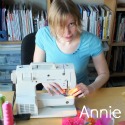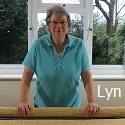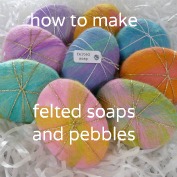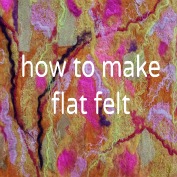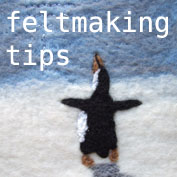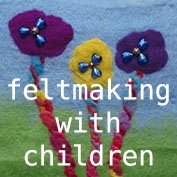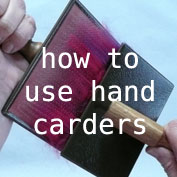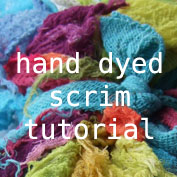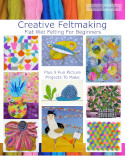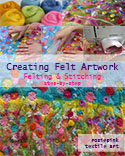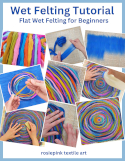made from Cotton Scrim, Merino Wool Tops/Roving and Silk Tops
The technique used in this project is called Nuno Felting (nuno is the Japanese word for cloth or fabric) and the felt is made by combining wool with a thin fabric so that you get a fine but strong felt that drapes well.
You will need:
A piece of natural cotton scrim (15% larger than you want the finished runner to be)
Merino wool top/roving in white (to give you an idea, we used 35g)
Silk tops in white (just a couple of grams)
2 pieces of bubble wrap 10-15 cms larger all round than the piece of scrim
Piece of tutu net or old net curtain same size as the bubble wrap
String or old yarn
Soap (we use Ecover washing-up liquid and Olive Oil soap)
Spray bottle
Work surface that will tolerate getting wet!
Fill a spray bottle with hand-hot water and add a good squirt of washing-up liquid (do not shake the bottle as frothy liquid doesn’t squirt well).
Lay 1 piece of bubble wrap out flat on your work surface (bubbles up).
Lay the scrim centrally on the bubble wrap (trim off any selvage edges).
Pull off pieces of merino top/roving....
Don’t worry about thick and thin patches – you are aiming to produce a table runner that would grace Miss Haversham’s table (Miss Haversham is the jilted bride in Charles Dickens “Great Expectations”). We could call it ‘shabby-chic’. It will have almost a lace look about it when finished.
Very carefully, lay the tutu net over the wool.
Spray the wool (through the net) until it’s wet but not swimming.
After a few minutes of rubbing, slowly peel the net off (leave it off this time) and cover the felt with the second piece of bubble wrap (bubbles down). Don’t panic if the silk seems to have disappeared – when the runner is dry the silk will re-appear.
Tightly roll the whole thing up and secure it with string or old yarn.
Gently roll it backwards and forwards for 3-4 minutes.
Unroll it, smoothing it out if necessary, then re-roll it the other way (short end to short end) and secure it with string or old yarn.
Roll it backwards and forwards for 3-4 minutes.
Repeat the rolling process until the fabric is firm and you cannot pinch any fibres away.
Very gently without too much agitation, rinse the table runner in tepid water until the water is clear then lift it from the bowl and let the water drain out naturally.
Lay the table runner in a clean towel, roll it up and roll it backwards and forwards to take most of the water out.
Put your table runner to dry flat.
When it’s dry, press with a warm iron on the reverse side.
This is just a basic introduction to the technique - you could experiment further and make other items such as scarves or lamps, and use different inclusions in the felt such as yarns, different types and colours of silk, and hand and machine stitching once the project is dry.
 Follow us on Instagram
Follow us on Instagram
